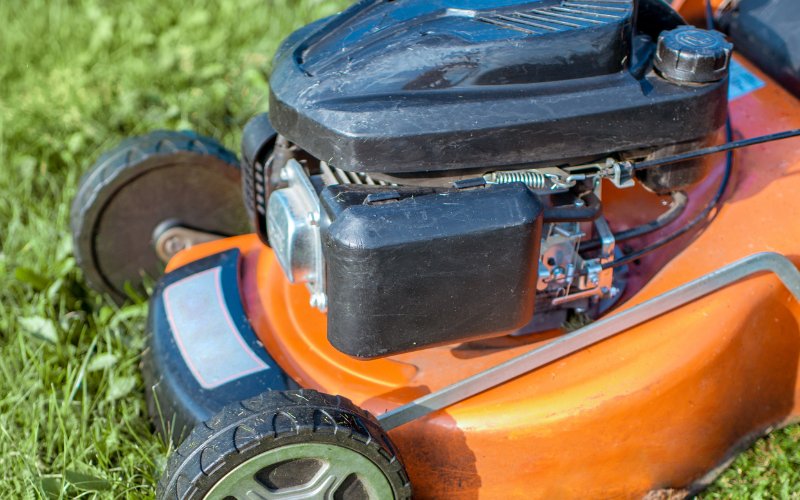Your lawn mower has sat for a while, and you discover the gas has gone bad. Not to worry, the good thing is you noticed it before it became a problem, or I hope you did. If you miss the signs of bad fuel, you could be inviting problems. The best solution to bad gas is to remove it and get fresh gas back in the tank. In this article, I’ll explain how to fix bad gas in a lawn mower and the steps you should take.

Confirming Your Mower Issues Are Caused By Bad Gas
If you’re reading this article, you are probably already experiencing various symptoms caused by bad gas. Just to be sure, symptoms of bad gas in a lawn mower include difficulty starting, poor idling, and engine stalling. If you have noticed any of these things, then a quick fuel discoloration test will confirm it.
How Bad Gas Can Affect Your Mower
As gasoline ages, it puts the engine components at risk. These risks affect the lawn mower both when in storage and while in use. When gasoline ages and goes bad, it evaporates and loses its volatile elements. Because the fuel is no longer as combustible, the engine has trouble starting.
When gas evaporates, it leaves behind a fuel gum. This gum is a thick, sticky, and resinous byproduct that clogs fuel lines, filters, pumps, and carburetors. If this gum reaches the engine components, parts like the fuel filter and lines will need to be replaced, and carburetors and cylinder heads will need to be overhauled.
Additionally, E10 ethanol gasoline makes up 98% of fuel sold in the USA, meaning that your fuel is more than likely hygroscopic and is 10% ethanol based. Hygroscopic means it attracts water.
The longer E10 fuel stays in your lawn mower, the more water it attracts. As a result, corrosion of metal within the engine components will occur. This means that parts such as carburetors, cylinder heads, and pistons can be destroyed if they stay in contact with degrading or bad fuel for too long.
Equipment You’ll Need to Fix a Mower With Bad Gas
Now that you know the damage bad gas can cause to your lawn mower, you’re likely eager to learn how to get old gas out of your lawn mower. Here is a list of tools you’ll need to ensure you can get the gas out safely and easily.
- Large Gas Container
- Small Gas Container
- Fuel Transfer Pump/Siphon
- Screwdriver
- Pliers
Bad Gas in Your Lawn Mower: How to Fix (My Guide)
You’ll want to approach getting old gas out of a lawn mower in two stages. The first stage is to remove the fuel from the fuel tank. Secondly, you’ll need to remove the remaining fuel within the fuel system. Combined, these two stages will limit the amount of bad fuel that runs through the lawn mower and puts the parts previously mentioned at risk.
Stage 1 – Removing the Bad Fuel from the Fuel Tank
Firstly, place your lawn mower in a well-ventilated area because of fuel fumes. I suggest doing this job on the driveway or in the garage with open doors.
Position the Large Gas Container
Next to the mower, place a fuel can that is big enough to receive the fuel in the lawn mower’s tank. Ensure that the container is close enough that the pump or siphon can reach the container and the lawn mower’s fuel tank comfortably.
Position the Pump/Siphon
Once in position, take your fuel transfer pump or siphon and place the inflow end into the mower’s fuel tank and the outflow end into the gas container.
Start Pumping/Siphoning
Start your pump/siphon and begin transferring the bad gas. Ensure that the pump/siphon stays low in the lawn mower’s gas tank so that transfer can be completed fully. If the pump/siphon process stops during transfer, it may be hard to restart the process.
Complete the Transfer of Stale Gas
Once the gas transfer has been completed, remove the pump/siphon. Next, seal the large gas container and store it safely out of the way along with the pump/siphon.
Stage 2 – Removing the Bad Fuel from the Fuel System
Like before, ensure that you are in a well-ventilated area.
Disconnect the Spark Plug
This stage requires you to crank the engine, but first, you need to prevent the engine from starting. To do this, leave the spark plug in place, disconnect the connecting ignition cable, and tuck it out of the way.
Position the Small Fuel Container
Next, get a small container, like a cup, which is small enough to fit in place and catch the fuel. Then place the small fuel container under the connection between the fuel line and carburetor.
Removing the Fuel Line Clamp
Use a pair of pliers or screwdriver to remove the clamp that holds the fuel line onto the carburetor.
Removing the Fuel Line
Next, pull the fuel line off the carburetor and place it into the small fuel container.
Crank the Lawn Mower’s Engine
With everything in place, crank the engine to force the fuel through the line. For this step, you might want some help to ensure the fuel line and container remain in place. Continue cranking the engine until no more fuel exits the fuel line.
Reinstall the Fuel Line
Dispose of the fuel container and place the fuel line back onto the carburetor. Then reinstall the fuel line clamp and tighten it firmly.
Reinstall the Spark Plug
Next, reattach the ignition cable to the spark plug.
Fill the Lawn Mower’s Fuel Tank
With the fix complete, you can refill the fuel tank with new gas.
Test the Lawn Mower
Finally, you need to test the lawn mower. Getting the new fuel into the system will take a few pulls. Let the mower run for about five minutes, listen for any idling speed problems, and see if the engine stalls. After the lawn mower runs for a few minutes without a problem, switch it off. Finally, restart the engine and see how it strikes up. Hopefully, this time it will only take a single pull.
Other Parts to Consider Fixing
Now that you have successfully followed the steps for how to fix bad gas in a lawn mower, you might want to consider other potential issues. There may be other problems you need to take care of due to bad fuel. If you experience problems after filling the tank with new gas, take a quick look at the list below as these could be potential issues you need to address next.
- Fuel Tank Filter Replacement
- Fuel Filter Replacement
- Fuel Line Cleaning & Replacement


Leave a Reply